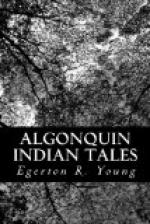Very cordial were their greetings, but soon the quick eyes of the kindly Indian noticed that there were several long red scratches and even some drops of partly dried blood on the hands of his little friends. It was hardly necessary for him to ask the cause of the wounds, as the bunches of sweet briers and wild roses, with their sharp needle-like thorns, in the happy children’s hands told the tale.
Putting down his gun and game, Souwanas quickly gathered some of the sweet fragrant grass which is there so abundant, and skillfully twisting it into little coils he wound one around each of the bunches of flowers which the children had gathered, and which they were still having trouble to hold on account of the thorns.
The bouquets thus arranged could now be carried without inflicting any more wounds or pain. Amid their chat and laughter, for these white children were taught, like Indian children, not to be afraid of a few scratches or a little pain, Minnehaha, who was industriously wiping the blood from some wounds on her little white hands with her apron, said:
“How is it, Souwanas, that all these rosebushes and briers have such sharp thorns on them?”
“I suppose Mary would say that Nanahboozhoo, the rascal, had something to do with it,” put in Sagastao.
At this reference to Mary there was a mischievous twinkle in the eyes of the old Indian.
“Yes,” he replied, “Nanahboozhoo had lots to do with it, and yet when you hear the story you will see that he was not such a rascal at the time he did it as Mary would make out, but almost as good as her pet, Wakonda, who gave the bees their stings.”
“O tell us all about it now,” said Minnehaha. “We have this forenoon as a half holiday, and papa is to join us in about an hour for a walk in the woods.”
The kind-hearted old Indian had been pleased with the plucky way in which the children had slighted their wounded hands, and before he began his story he acted the part of the skillful physician. He found some soft juicy leaves which he crushed and spread on the ugly red scratches. The effect was magical, and the children who had so bravely treated their wounds with indifference gratefully acknowledged the sudden cessation of the smart.
Selecting a pretty spot under a clump of balsam trees, where some boulder-like stones afforded them comfortable seats, the children cuddled down with their old friend, to hear how the roses got their thorns.
“Long ago the roses were the most abundant of flowers, but they grew on bushes that were smooth and fragrant, and such delicious eating that all the animals that eat grass or browse were constantly seeking for and devouring not only the rose flowers but also the bushes on which they grew. The result was that the roses of all kinds were in danger of being exterminated. In those days trees and flowers and other things had greater powers of thinking and acting than they have now, and so the roses of different kinds met in council to decide what could be done to preserve those of them that were still left in existence. It was decided that a deputation of them should be sent to Nanahboozhoo to implore his assistance.




